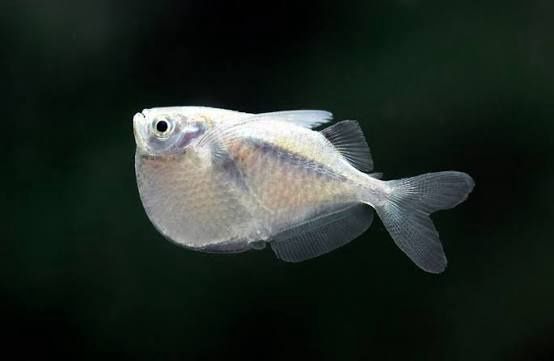Thoracocharax Stellatus Hatchet Fish
Giant Hatchetfish (Thoracocharax securis) Care Guide
Common Names: Giant Hatchetfish, River Hatchetfish
Scientific Name: Thoracocharax securis
Origin: Amazon River Basin (South America)
Size: Up to 6–7 cm (about 2.5 inches)
Lifespan: 3–5 years
Temperament: Peaceful, shy
Difficulty: Moderate
✅ Tank Requirements
-
Minimum Tank Size: 75 liters (for a group)
-
Temperature: 24–28°C
-
pH: 6.0–7.4
-
Hardness: Soft to moderately hard (2–10 dGH)
-
Lighting: Low to moderate (prefer dim environments)
-
Substrate: Sand or fine gravel
-
Aquascape:
-
Dense vegetation or floating plants (to provide shade and reduce stress)
-
Open surface area for swimming
-
Tightly sealed lid (they are extreme jumpers!)
-
Behavior and Tank Mates
-
Top-dwelling and extremely surface-oriented
-
Very skittish, especially in bright light or loud environments
-
Should be kept in groups of 6 or more for comfort
Good tank mates:
-
Peaceful, mid- or bottom-dwelling species (e.g. Corydoras, Otocinclus)
-
Small tetras (like ember or cardinal tetras)
-
Pencilfish, rasboras, or Apistogramma (if not aggressive)
Avoid:
-
Aggressive or large fish (they stress easily)
-
Fast-swimming fish that dominate feeding time
️ Diet
In the wild, T. securis feeds on flying insects and tiny aquatic invertebrates.
In the aquarium:
-
Prefers floating foods
-
Feed:
-
Live or frozen insect larvae (mosquito larvae, fruit flies)
-
Daphnia or baby brine shrimp
-
Floating micro-pellets
-
Crushed flakes
-
They rarely eat sinking food — always offer meals near the surface.
Breeding
Breeding Thoracocharax securis in captivity is very rare and difficult.
-
Requires very soft, acidic water and low light
-
Eggs are scattered near floating plants
-
Adults may eat the eggs — separate them immediately if spawning occurs
Interesting Fact
The Giant Hatchetfish is not just named for its shape—its enlarged, muscular pectoral region gives it the ability to launch itself out of the water and glide for short distances, much like flying fish! In fact, its pectoral muscles are so well developed that they take up nearly 25% of its body weight—a unique adaptation among freshwater fish.

